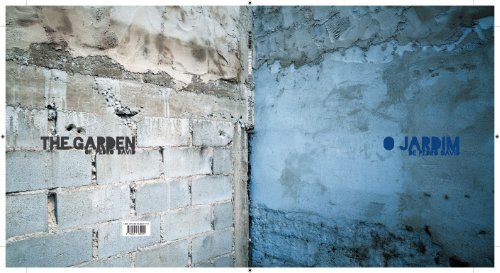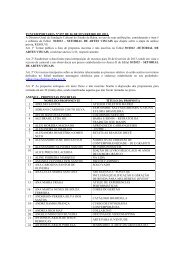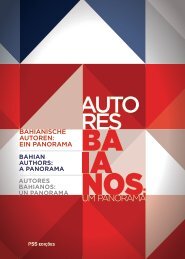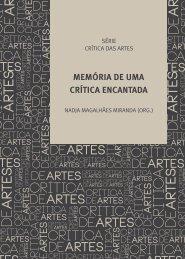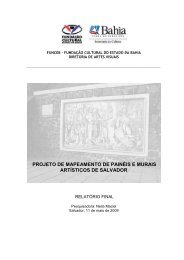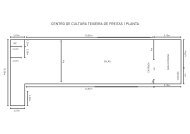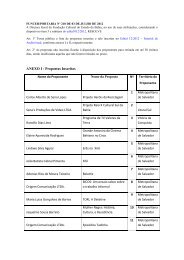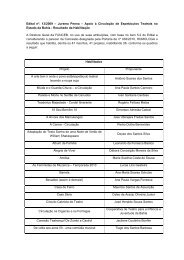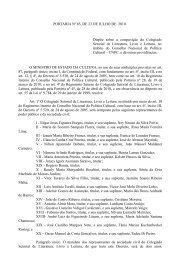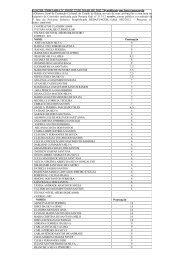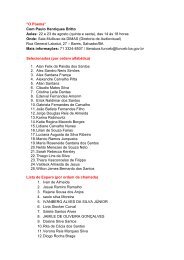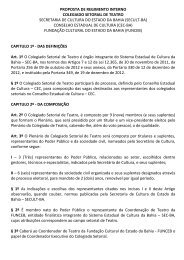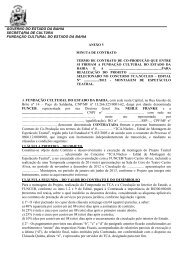Fazer download PDF - Fundação Cultural do Estado da Bahia
Fazer download PDF - Fundação Cultural do Estado da Bahia
Fazer download PDF - Fundação Cultural do Estado da Bahia
You also want an ePaper? Increase the reach of your titles
YUMPU automatically turns print PDFs into web optimized ePapers that Google loves.
O Jardim<br />
de pedro <strong>da</strong>vid<br />
Terra Vermelha<br />
Alejandro Castellote<br />
Prêmio Nacional de Fotografia Pierre Verger<br />
2012
THE garden<br />
OF pedro <strong>da</strong>vid<br />
RED EARTH<br />
Alejandro Castellote<br />
Pierre Verger National prize of Photography<br />
2012
Some words about the Pierre Verger National Award<br />
of Photography<br />
The invention of Photography in the nineteenth century was<br />
a major revolution in technology and culture. It entered the<br />
process of subsumption of culture to the capital and it had<br />
been enrolled in the process of opening new reproductive<br />
technologies geared specifically to symbolic goods. These<br />
goods were excluded, up to that moment, from the reach of<br />
technological change, originated in the “industrial revolution”<br />
of the late eighteenth century, which aimed only the technical<br />
reproduction of material goods.<br />
The revolution of technical reproduction of symbolic goods,<br />
launched with the appearance of new printing machines in the<br />
1830s, replaced the archaic craft printers modeled since its<br />
invention by Gutenberg. On its photographic moment, it allowed<br />
for a huge leap in technology reproduction: beyond words, it<br />
was now possible to portray images.<br />
The technical reproduction of images meant a technological<br />
breakthrough with notable impact on contemporary life. It<br />
transformed the image into an every<strong>da</strong>y object, starting their<br />
proliferation and their subsequent banalization, in an current<br />
life increasingly flooded with images.<br />
Photography, originally understood as a mere possibility of<br />
technical reproduction, had deep and fruitful cultural effects,<br />
such as the consequent change in the secular art of painting. It<br />
freed painting from its figurative “mission”, opening multiple<br />
paths for its further development. Nothing casual was the<br />
broadening in the horizon of aesthetic languages experienced by<br />
painting in the late nineteenth and early twentieth centuries.<br />
This new world of images, with more and more sophisticated<br />
technological devices, began with Photography. But the<br />
nineteenth century and especially in the twentieth century,<br />
many photographers have contributed to this move by building<br />
unique aesthetics and turning Photography into Art, even when<br />
it is still dedicated to portraying reality.<br />
The Secretary of Culture of the State of <strong>Bahia</strong> understands<br />
Photography as an art expression that is most attuned to this<br />
world of proliferating images, which we call contemporaneity.<br />
Hence the institution of the Pierre Verger National Prize of<br />
Photography, held every two years since 2002. To<strong>da</strong>y, this is one<br />
of the greatest prizes in the country. It includes a cash award,<br />
an exhibition to be held in Salva<strong>do</strong>r and the publication of a<br />
catalog with the photographic essay.<br />
We are now celebrating Pedro David, winner of the prize in<br />
2010/2011. The Garden is an photo essay that, as confirmed the by<br />
the author, seeks “to understand the expansion of the city out<br />
of its boun<strong>da</strong>ries; the clash between its inhabitants with nature<br />
and the reasons that lead people who are so different, to look<br />
for the same pieces of land in the periphery. “ This is a very<br />
current issue for Brazil, a growing country that incorporates<br />
marginalized sectors and revitalizes neighborhoods, but<br />
also still shows up as extremely unequal, tense and marked by<br />
political, cultural and environmental demands.<br />
Special places, the periphery nowa<strong>da</strong>ys condense many<br />
challenges but also potential social, economic, political and<br />
cultural processes of change already underway in Brazil. To<br />
look at them to understand their dynamics, to stimulate their<br />
potential emerge as an urgent task, including in the cultural<br />
field, often engaged elsewhere and apart from the complexity<br />
of vital struggles in contemporary Brazil. Hard realities,<br />
dense, conflicted and beautiful images revealed by the creative<br />
imaginary of Pedro David.<br />
Algumas palavras acerca <strong>do</strong> Prêmio Nacional de<br />
Fotografia Pierre Verger<br />
A invenção <strong>da</strong> fotografia no século XIX foi uma enorme revolução<br />
em termos tecnológicos e culturais. Ela se inseriu no processo<br />
de subsunção <strong>da</strong> cultura ao capital e se inscreveu no processo de<br />
inauguração de novas tecnologias de reprodução técnica volta<strong>da</strong>s<br />
especificamente para bens simbólicos. Tais bens estavam<br />
excluí<strong>do</strong>s até aquele momento <strong>do</strong> alcance <strong>da</strong>s transformações<br />
tecnológicas, origina<strong>da</strong>s na “revolução industrial” <strong>do</strong> final <strong>do</strong><br />
século XVIII e volta<strong>da</strong>s somente para a reprodução técnica <strong>do</strong>s<br />
bens materiais.<br />
A revolução <strong>da</strong> reprodução técnica de bens simbólicos, inaugura<strong>da</strong><br />
com o aparecimento <strong>da</strong>s novas máquinas de imprimir <strong>do</strong>s anos 30<br />
<strong>do</strong> século XIX, que substituíram as artesanais e já arcaicas<br />
impressoras modela<strong>da</strong>s desde sua invenção por Gutenberg, em<br />
seu instante fotográfico permitiu um salto qualitativo nas<br />
tecnologias de reprodução: além de palavras, agora era possível<br />
retratar imagens.<br />
A reprodução técnica de imagens fixas significou um avanço<br />
tecnológico com notáveis impactos na vi<strong>da</strong> contemporânea, pois<br />
transformou a imagem em um objeto cotidiano, inician<strong>do</strong> sua<br />
proliferação e sua posterior banalização em uma atuali<strong>da</strong>de ca<strong>da</strong><br />
vez mais inun<strong>da</strong><strong>da</strong> de imagens.<br />
A fotografia, originalmente entendi<strong>da</strong> como mera possibili<strong>da</strong>de<br />
de reprodução técnica, teve repercussões culturais profun<strong>da</strong>s<br />
e fecun<strong>da</strong>s, a exemplo <strong>do</strong> que aconteceu com a secular arte <strong>da</strong><br />
pintura. Ela libertou a pintura de sua “missão” figurativa,<br />
abrin<strong>do</strong> múltiplas vere<strong>da</strong>s para seu desenvolvimento posterior.<br />
Na<strong>da</strong> casual o alargamento <strong>do</strong> horizonte de linguagens estéticas<br />
que a pintura experimentou no final <strong>do</strong> século XIX e início <strong>do</strong> XX.<br />
Este novo mun<strong>do</strong> de imagens, com dispositivos tecnológicos<br />
fotografia enquanto mera técnica de reprodução. Já no século XIX<br />
e, em especial, no século XX, inúmeros fotógrafos contribuíram<br />
para isso, construin<strong>do</strong> uma estética singular e transforman<strong>do</strong><br />
a fotografia em artes, mesmo quan<strong>do</strong> ain<strong>da</strong> se dedica a retratar<br />
reali<strong>da</strong>des.<br />
A Secretaria de Cultura <strong>do</strong> Esta<strong>do</strong> <strong>da</strong> <strong>Bahia</strong> entende a fotografia<br />
como uma <strong>da</strong>s artes mais sintoniza<strong>da</strong>s com este mun<strong>do</strong> de imagens<br />
proliferantes, que chamamos de contemporanei<strong>da</strong>de. Daí a<br />
instituição <strong>do</strong> Prêmio Nacional de Fotografia Pierre Verger,<br />
realiza<strong>do</strong> a ca<strong>da</strong> <strong>do</strong>is anos desde 2002. Hoje, este é um <strong>do</strong>s<br />
maiores prêmios <strong>do</strong> país. Ele abrange uma premiação em dinheiro,<br />
uma exposição a ser realiza<strong>da</strong> em Salva<strong>do</strong>r e a publicação de um<br />
catálogo com o ensaio fotográfico.<br />
Estamos agora festejan<strong>do</strong> Pedro David, vence<strong>do</strong>r <strong>do</strong> Prêmio em<br />
2010/2011. O ensaio fotográfico O Jardim, como confirmou o<br />
próprio autor, procura “entender a expansão <strong>da</strong> ci<strong>da</strong>de para fora<br />
de seus limites, o embate entre seus habitantes com a natureza e<br />
as razoes que levam pessoas tão diferentes a procurar os mesmos<br />
pe<strong>da</strong>ços <strong>da</strong> periferia”. Tema atualíssimo em um Brasil que cresce,<br />
incorpora setores excluí<strong>do</strong>s e revitaliza periferias, mas ain<strong>da</strong><br />
se revela profun<strong>da</strong>mente desigual, tenso e marca<strong>do</strong> por desafios<br />
políticos, culturais e ambientais.<br />
Lugares especiais, as periferias na atuali<strong>da</strong>de condensam<br />
desafios e muitas <strong>da</strong>s potenciali<strong>da</strong>des sociais, econômicas,<br />
políticas e culturais <strong>do</strong> processo de mu<strong>da</strong>nça em curso no<br />
Brasil. Olhar para elas, entender suas dinâmicas, estimular<br />
seus potenciais emergem como tarefas urgentes, inclusive<br />
<strong>do</strong> campo cultural, quase sempre tão enquista<strong>do</strong> em outros<br />
lugares e aparta<strong>do</strong> <strong>da</strong> complexi<strong>da</strong>de <strong>do</strong>s embates vitais <strong>da</strong><br />
contemporanei<strong>da</strong>de brasileira. Reali<strong>da</strong>des duras, densas,<br />
conflituosas e belas revela<strong>da</strong>s pelo criativo olhar imaginário<br />
de Pedro David.<br />
multiplication of images subverted the original role of<br />
Photography as a mere reproduction technique. In the<br />
Antonio Albino Canelas Rubim<br />
Secretary of Culture of <strong>Bahia</strong> State<br />
ca<strong>da</strong> vez mais sofistica<strong>do</strong>s, nasceu com a fotografia. Mas<br />
a multiplicação de imagens subverteu o papel original <strong>da</strong><br />
Antonio Albino Canelas Rubim<br />
Secretário de Cultura <strong>da</strong> <strong>Bahia</strong><br />
4 5
Exchange of artistic references<br />
The <strong>Cultural</strong> Foun<strong>da</strong>tion of <strong>Bahia</strong> (FUNCEB) is the unit of<br />
the Secretary of Culture of <strong>Bahia</strong> (SecultBA) responsible<br />
Intercâmbio de referências artísticas<br />
for public policies to promote the arts. It promotes and<br />
A Fun<strong>da</strong>ção <strong>Cultural</strong> <strong>do</strong> Esta<strong>do</strong> <strong>da</strong> <strong>Bahia</strong> (FUNCEB) é a uni<strong>da</strong>de<br />
encourages the formation, production, research, and<br />
dissemination of artistic languages and memory, having<br />
undertaken as a priority the dissemination of the work of<br />
not only <strong>Bahia</strong> artists, but also Brazilians, recognizing<br />
their qualified, innovative and contemporary characters.<br />
The FUNCEB considers the exchange of references and<br />
productions made in the country indispensable to qualify<br />
the arts in <strong>Bahia</strong> and Brazil.<br />
The Pierre Verger National Prize of Photography, created<br />
in 2002, is one of the most important photo contests in the<br />
country. With biannual editions, this event is undertaken<br />
by FUNCEB, a foun<strong>da</strong>tion focusing on the development of<br />
the arts in the state of <strong>Bahia</strong>. It is lined up with the<br />
commitment of being inserted in the cultural reality of<br />
Brazil, following what is revealing to be rich and new in<br />
the national production. In this fourth edition, the award<br />
has confirmed its potential to value works of excellence in<br />
Brazilian photography.<br />
The selection committee, formed by José Carlos Mamede<br />
(Professor of Photography at the Faculty of Communications<br />
at the Federal University of <strong>Bahia</strong>), Leonar<strong>do</strong> Costa Braga<br />
(Photographer, winner of the third edition of the Pierre<br />
Verger National Prize of Photography and Sergio Burgi<br />
(Coordinator of Photography at Instituto Moreira Salles),<br />
indicated Pedro David, born in Santos Dumont (MG) for his<br />
work of “excellent aesthetic quality, moving and reflecting<br />
on relevant aspects of contemporary photographic<br />
language, while in dialogue with traditional aspects of the<br />
classic and modern Photography”.<br />
In his Garden Project, the young photographer seeks to<br />
combine technique, working with 4x5-inch sheets, specific<br />
to large format Photography and currently little explored<br />
in the digital world, to the approach of contemporary<br />
issues, dealing with the relationship between civilization<br />
and nature, large cities, suburbs and human feelings.<br />
<strong>da</strong> Secretaria de Cultura <strong>do</strong> Esta<strong>do</strong> <strong>da</strong> <strong>Bahia</strong> (SecultBA)<br />
responsável pelas políticas públicas de fomento às artes.<br />
Promove e incentiva a formação, a produção, a pesquisa, a<br />
difusão e a memória <strong>da</strong>s linguagens artísticas, ten<strong>do</strong> como<br />
uma <strong>da</strong>s priori<strong>da</strong>des assumi<strong>da</strong>s a divulgação <strong>do</strong>s trabalhos<br />
<strong>do</strong>s artistas, não apenas baianos, mas essencialmente<br />
brasileiros, reconhecen<strong>do</strong> seu caráter qualifica<strong>do</strong>,<br />
inova<strong>do</strong>r, contemporâneo. A FUNCEB considera o intercâmbio<br />
de referências e produções realiza<strong>da</strong>s no país uma forma<br />
indispensável de qualificar a arte na <strong>Bahia</strong> e no Brasil.<br />
O Prêmio Nacional de Fotografia Pierre Verger, cria<strong>do</strong> em<br />
2002, é um <strong>do</strong>s maiores concursos para trabalhos fotográficos<br />
<strong>do</strong> país. Com edições bianuais, a realização deste certame<br />
pela FUNCEB, enquanto fun<strong>da</strong>ção com foco no desenvolvimento<br />
<strong>da</strong>s artes no esta<strong>do</strong> <strong>da</strong> <strong>Bahia</strong>, se linha ao seu compromisso de<br />
estar inseri<strong>da</strong> na reali<strong>da</strong>de cultural <strong>do</strong> Brasil e de acompanhar<br />
o que se revela de rico e novo na produção nacional. Nesta<br />
quarta edição, o Prêmio confirmou seu potencial de valorizar<br />
A comissão de seleção, forma<strong>da</strong> por José Carlos Mamede<br />
(professor de fotografia <strong>da</strong> Facul<strong>da</strong>de de Comunicação<br />
<strong>da</strong> Universi<strong>da</strong>de Federal <strong>da</strong> <strong>Bahia</strong>), Leonar<strong>do</strong> Costa Braga<br />
(fotógrafo, vence<strong>do</strong>r <strong>da</strong> terceira edição <strong>do</strong> Prêmio Nacional<br />
de Fotografia Pierre Verger) e Sérgio Burgi (coordena<strong>do</strong>r de<br />
Fotografia <strong>do</strong> Instituto Moreira Salles), indicou Pedro David,<br />
natural de Santos Dumont (MG), por seu trabalho de “excelente<br />
quali<strong>da</strong>de estética, transitan<strong>do</strong> e refletin<strong>do</strong> sobre aspectos<br />
relevantes <strong>da</strong> linguagem fotográfica contemporânea, ao<br />
mesmo tempo em que dialoga com vertentes tradicionais <strong>da</strong><br />
fotografia clássica e moderna”.<br />
No projeto O Jardim, o jovem fotógrafo mineiro busca aliar a<br />
técnica, trabalhan<strong>do</strong> com chapas de 4x5 polega<strong>da</strong>s, específica<br />
para fotografia em formato grande, hoje pouco explora<strong>da</strong> no<br />
universo digital, à abor<strong>da</strong>gem de questões contemporâneas,<br />
ao tratar de relações entre civilização e natureza, grandes<br />
ci<strong>da</strong>des, periferias e sensações humanas.<br />
A total of 109 sets of photographic subjects, with free<br />
techniques, 44 of them from <strong>Bahia</strong> and the remaining 65<br />
from other states such as Amazonas, Ceará, Mato Grosso,<br />
Minas Gerais, Paraná, Pernambuco, Rio de Janeiro, Rio<br />
It is an honour for the <strong>Cultural</strong> Foun<strong>da</strong>tion of <strong>Bahia</strong> to<br />
enable that the Garden of Pedro David becomes public,<br />
through this catalogue, which is one of the results of the<br />
Pierre Verger National Prize of Photography.<br />
trabalhos de excelência <strong>da</strong> fotografia brasileira.<br />
Foram inscritos 109 conjuntos fotográficos de temáticas e<br />
técnicas livres, 44 deles <strong>da</strong> <strong>Bahia</strong> e as outros 65 oriun<strong>do</strong>s<br />
de esta<strong>do</strong>s como Amazonas, Ceará, Mato Grosso, Minas Gerais,<br />
É uma honra para a Fun<strong>da</strong>ção <strong>Cultural</strong> <strong>do</strong> Esta<strong>do</strong> <strong>da</strong> <strong>Bahia</strong><br />
possibilitar que se torne público O Jardim de Pedro David,<br />
por meio deste catálogo, que constitui um <strong>do</strong>s resulta<strong>do</strong>s <strong>do</strong><br />
Prêmio Nacional de Fotografia Pierre Verger.<br />
Grande <strong>do</strong> Norte, Rio Grande <strong>do</strong> Sul, Santa Catarina, Sao<br />
Paulo and Brasilia.<br />
Nehle Franke<br />
Director of the <strong>Cultural</strong> Foun<strong>da</strong>tion of <strong>Bahia</strong> State (FUNCEB)<br />
Paraná, Pernambuco, Rio de Janeiro, Rio Grande <strong>do</strong> Norte, Rio<br />
Grande <strong>do</strong> Sul, Santa Catarina, São Paulo e Distrito Federal.<br />
Nehle Franke<br />
Diretora <strong>da</strong> Fun<strong>da</strong>ção <strong>Cultural</strong> <strong>do</strong> Esta<strong>do</strong> <strong>da</strong> <strong>Bahia</strong> (FUNCEB)<br />
6 7
A Garden under the weight of the sky<br />
Um Jardim sob o peso <strong>do</strong> céu<br />
With the completion of this fourth edition of the Pierre<br />
Verger National Prize of Photography, the Coordination<br />
of Visual Arts of the <strong>Cultural</strong> Foun<strong>da</strong>tion of <strong>Bahia</strong> hopes<br />
to contribute to the encouragement and appreciation of<br />
Brazilian photographic production, a just tribute to the<br />
French photographer who participated in the construction<br />
of identity in <strong>Bahia</strong> and Brazil. In a fierce dispute,<br />
competing with great names in our national Photography,<br />
Pedro David won the contest with The Garden, a contemporary<br />
poetic and universal project.<br />
Photography increasingly asserts itself as one of<br />
the great expressions of Contemporary Art. Poetry,<br />
technique, aesthetics, social essay and political<br />
activism may fit in a single image, as shown. Increasingly<br />
popular, Photography is facing the challenge to overcome<br />
its own boun<strong>da</strong>ries, establishing itself as a creative and<br />
renewing artistic language.<br />
Pedro David chose the landscape on the outskirts of Belo<br />
Horizonte to show us that progress and fast development<br />
can also leave painful marks, before it even starts. A body,<br />
a tree, lying on a red ground, in ruins under the weight of<br />
the sky. Image synthesis of a set of impressions left by a<br />
socioeconomic system that builds ruining. A chaotic growth<br />
that misleads us: is this the beginning or the end? Will<br />
homes, schools, streets, squares and gardens be built or<br />
everything is gone? Where are the people?<br />
Pedro’s photos go beyond denouncement and reach another<br />
ground: that of art, where feelings, memories and the (old)<br />
aesthetic pleasure rule. Frame, light and a cinematographic<br />
color testify the maturing of an artist who is far from an<br />
easy solution for the “Brazilian identity” and yet, it is<br />
there, in its most cruel and melancholic.<br />
By presenting The Garden, cultivated by Pedro David to the<br />
public, the Secretary of Culture of the State of <strong>Bahia</strong>,<br />
through its <strong>Cultural</strong> Foun<strong>da</strong>tion, meets, once again, its<br />
mission to contribute to the dissemination of visual arts<br />
and to enrich the national symbolic production.<br />
Luciana Vasconcelos<br />
Coordinator of Visual Arts, <strong>Cultural</strong> Foun<strong>da</strong>tion of <strong>Bahia</strong> (FUNCEB)<br />
Com a realização <strong>da</strong> quarta edição <strong>do</strong> Prêmio Nacional de<br />
Fotografia Pierre Verger, a Coordenação de Artes Visuais <strong>da</strong><br />
Fun<strong>da</strong>ção <strong>Cultural</strong> <strong>do</strong> Esta<strong>do</strong> <strong>da</strong> <strong>Bahia</strong> espera contribuir para<br />
o incentivo e a valorização <strong>da</strong> produção fotográfica no país,<br />
uma justa homenagem ao fotógrafo francês que participou <strong>da</strong><br />
construção <strong>da</strong> identi<strong>da</strong>de baiana e brasileira. Em uma disputa<br />
acirra<strong>da</strong>, concorren<strong>do</strong> com grandes nomes <strong>da</strong> fotografia<br />
nacional, Pedro David venceu o concurso apresentan<strong>do</strong> “O<br />
Jardim”, uma proposta contemporânea, poética e universal.<br />
A fotografia ca<strong>da</strong> vez mais se afirma como uma <strong>da</strong>s grandes<br />
expressões <strong>da</strong> arte contemporânea. Poesia, técnica,<br />
estética, crônica social, ativismo político podem caber em<br />
uma só imagem, imediata. A fotografia tem pela frente o<br />
grande desafio de se superar, firman<strong>do</strong>-se como linguagem<br />
artística criativa e renova<strong>do</strong>ra.<br />
Pedro David escolheu a paisagem, quase desértica, <strong>da</strong><br />
periferia de Belo Horizonte para nos mostrar que progresso<br />
e desenvolvimento acelera<strong>do</strong> também podem deixar <strong>do</strong>lorosas<br />
marcas, antes mesmo de começar. Um corpo, uma árvore, jaz<br />
em uma terra rubra, escalavra<strong>da</strong>, sob o peso <strong>do</strong> céu. Imagem<br />
síntese <strong>do</strong> conjunto de impressões deixa<strong>da</strong>s por um sistema<br />
socioeconômico que constrói arruinan<strong>do</strong>. Um crescimento<br />
caótico que nos desorienta: isto é o começo ou o fim? Casas,<br />
escolas, aveni<strong>da</strong>s, praças e jardins serão construí<strong>do</strong>s ou<br />
tu<strong>do</strong> já se foi? Onde estão as pessoas?<br />
As fotos de Pedro vão além <strong>da</strong> denúncia e alcançam outro<br />
terreno: o <strong>da</strong> arte, onde sentimentos, memórias e o (velho)<br />
prazer estético <strong>do</strong>minam. Enquadramentos, luz e cores<br />
cinematográficas testemunham o amadurecimento de um<br />
artista que está longe <strong>da</strong> fácil solução <strong>da</strong> “identi<strong>da</strong>de<br />
brasileira” e, no entanto, ela está lá, no que tem de mais<br />
cruel e melancólico.<br />
Ao apresentar ao público um “Jardim”, cultiva<strong>do</strong> pelo<br />
fotógrafo Pedro David, a Secretaria de Cultura <strong>do</strong> Esta<strong>do</strong> <strong>da</strong><br />
<strong>Bahia</strong>, através <strong>da</strong> Fun<strong>da</strong>ção <strong>Cultural</strong>, cumpre, mais uma vez,<br />
sua missão de contribuir para a divulgação <strong>da</strong>s artes visuais e<br />
para o enriquecimento <strong>da</strong> produção simbólica nacional.<br />
Luciana Vasconcelos<br />
Coordena<strong>do</strong>ra de Artes Visuais <strong>da</strong> Fun<strong>da</strong>ção <strong>Cultural</strong> <strong>do</strong> Esta<strong>do</strong><br />
<strong>da</strong> <strong>Bahia</strong> (FUNCEB)<br />
8 9
For Marina<br />
Para Marina
66 67
Terra Vermelha:<br />
A viagem de um cartOgrafo dissidente.<br />
... Naquele Império, a Arte <strong>da</strong> Cartografia alcançou tal<br />
Perfeição que o Mapa de uma única Província ocupava to<strong>da</strong><br />
uma Ci<strong>da</strong>de, e o Mapa <strong>do</strong> Império, to<strong>da</strong> uma Província. Com o<br />
tempo, esses Mapas Desmesura<strong>do</strong>s não foram satisfatórios e<br />
os Colégios de Cartógrafos levantaram um Mapa <strong>do</strong> Império que<br />
tinha o Tamanho <strong>do</strong> Império e coincidia pontualmente com ele.<br />
Menos Afeitas ao Estu<strong>do</strong> <strong>da</strong> Cartografia, as Gerações Seguintes<br />
entenderam que esse dilata<strong>do</strong> Mapa era Inútil e não sem<br />
Impie<strong>da</strong>de o entregaram às Inclemências <strong>do</strong> Sol e <strong>do</strong>s Invernos.<br />
Nos Desertos <strong>do</strong> Oeste perduram despe<strong>da</strong>ça<strong>da</strong>s Ruínas <strong>do</strong> Mapa,<br />
habita<strong>da</strong>s por Animais e por Mendigos; em to<strong>do</strong> o País não há<br />
outra relíquia <strong>da</strong>s Disciplinas Geográficas.<br />
(Suárez Miran<strong>da</strong>: Viajes de varones prudentes, livro quarto, cap. XIV, 1658.)<br />
Do Rigor na Ciência. Jorge Luis Borges em O Faze<strong>do</strong>r (1960).<br />
O Jardim é um projeto leva<strong>do</strong> a cabo em <strong>do</strong>is bairros <strong>da</strong> região<br />
metropolitana de Belo Horizonte – Jardim Canadá e Vale <strong>do</strong><br />
Sol – situa<strong>do</strong>s às margens <strong>da</strong> ro<strong>do</strong>via BR-040. A periferia<br />
<strong>da</strong>s ci<strong>da</strong>des – um território mestiço onde a paisagem urbana<br />
se dilui na paisagem natural – é um <strong>do</strong>s temas estrelas <strong>da</strong><br />
fotografia contemporânea na última déca<strong>da</strong>; milhares de<br />
fotógrafos em to<strong>do</strong> o mun<strong>do</strong> têm se aproxima<strong>do</strong> destes nãolugares<br />
que abun<strong>da</strong>m em to<strong>do</strong> o tipo de civilizações. Sem<br />
dúvi<strong>da</strong>s, Pedro David esquiva-se <strong>da</strong>s representações já<br />
estereotipa<strong>da</strong>s e empreende uma viagem, minúscula em suas<br />
dimensões geográficas, na qual transparece sua própria<br />
experiência e se reconhecem, entre outros, os ecos <strong>da</strong><br />
literatura, <strong>da</strong> pintura, <strong>da</strong> escultura e <strong>da</strong> land art.<br />
Para entender o caráter poliédrico desta série, é<br />
recomendável observar retrospectivamente seus trabalhos<br />
anteriores, utilizan<strong>do</strong> também algumas projeções ideológicas<br />
inscritas historicamente na representação <strong>da</strong> natureza e<br />
<strong>da</strong> paisagem. “Natureza e paisagem”, como sugere Santiago<br />
Olmo, “não são coincidentes; uma vez que a paisagem é a<br />
porção <strong>da</strong> natureza contempla<strong>da</strong> e observa<strong>da</strong> como lugar<br />
específico ou geográfico em um tempo e estação <strong>do</strong> ano<br />
determina<strong>do</strong>s e constitui um fenômeno cultural; a natureza<br />
implica quali<strong>da</strong>des e notas de caráter ontológico, exige<br />
uma perspectiva global. A construção de seu conceito pode<br />
incluir o homem como um elemento a mais, mas exige um marco<br />
epistemológico científico” 1 .<br />
Desde o Renascimento, o olhar europeu sobre a paisagem se<br />
des<strong>do</strong>bra em duas visões: por um la<strong>do</strong>, a protocientífica,<br />
que considera a Natureza um corpo harmônico (macrocosmos)<br />
que se corresponde com o homem (microcosmos). Uma relação<br />
cujos mecanismos de compreensão são simbólicos. E por outro<br />
la<strong>do</strong>, a que considera a natureza uma ordem inerte regi<strong>da</strong> pela<br />
Divin<strong>da</strong>de to<strong>do</strong> poderosa, suscetível de ser quantifica<strong>da</strong>,<br />
medi<strong>da</strong>, comercializa<strong>da</strong>, manipula<strong>da</strong>, utiliza<strong>da</strong> e espolia<strong>da</strong><br />
com violência, como um presente <strong>da</strong><strong>do</strong> por Deus aos homens<br />
para sua subsistência, mas também para seu proveito. Essa<br />
é a concepção <strong>do</strong> nascente capitalismo protestante, que, no<br />
século XVI, converterá o mun<strong>do</strong> e a natureza em uma merca<strong>do</strong>ria.<br />
A paisagem é, desse ponto de vista, um lugar suscetível de ser<br />
utiliza<strong>do</strong> para a indústria ou o comércio, de ser transforma<strong>do</strong><br />
para gerar riquezas para a nação por meio <strong>da</strong> conquista e <strong>da</strong><br />
colonização de impérios 2 .<br />
Uma ilustração de como essa filosofia se trasla<strong>da</strong> à pintura<br />
colonial pode ser encontra<strong>da</strong> na obra <strong>do</strong> pintor holandês<br />
Frans Post, que acompanhou o séquito <strong>do</strong> príncipe Johan<br />
Maurits de Nassau na expedição <strong>da</strong> Companhia Holandesa <strong>da</strong>s<br />
Índias Ocidentais (1636-1644) para tomar posse <strong>da</strong> Colônia de<br />
Permanbuco – no nordeste <strong>do</strong> Brasil –, recém-conquista<strong>da</strong> <strong>do</strong>s<br />
portugueses. Nos óleos deste que é considera<strong>do</strong> o primeiro<br />
artista a pintar as paisagens <strong>do</strong> Novo Mun<strong>do</strong>, aprecia-se seu<br />
interesse em glorificar o território conquista<strong>do</strong>. Detémse,<br />
com rigor, na reprodução <strong>do</strong>s elementos exóticos, um<br />
tipo de enumeração precisa <strong>do</strong>s detalhes – de fato, intervém<br />
na realização de mapas –, cujo pano de fun<strong>do</strong> enuncia sem<br />
enfatizar o poder <strong>da</strong> Holan<strong>da</strong> 3 . Os pintores, como mais<br />
tarde fizeram os fotógrafos <strong>do</strong> século XIX, acompanhavam as<br />
expedições coloniais para glosar, em imagens, a importância<br />
<strong>do</strong> conquista<strong>do</strong>. Contu<strong>do</strong>, no que concerne à arte, poderíamos<br />
resumir sumariamente que a pintura calvinista apostava no<br />
retrato, isto é, na preeminência <strong>do</strong> indivíduo, enquanto,<br />
na católica, pre<strong>do</strong>minam as temáticas religiosas como<br />
instrumento de catequização.<br />
O caráter de superiori<strong>da</strong>de que o calvinismo outorgou à<br />
raça de seus fiéis, e a hierarquia na qual situou o homem a<br />
respeito <strong>da</strong> natureza aju<strong>da</strong>m a entender o comportamento <strong>do</strong>s<br />
impérios protestantes europeus no tocante às suas colônias;<br />
o que não exime os católicos de atitudes similares, apenas<br />
torna visíveis as diferenças. Para ilustrá-las, o norte e<br />
o sul <strong>do</strong> continente americano são exemplos ilustres. No<br />
caso <strong>da</strong> configuração urbana <strong>da</strong>s ci<strong>da</strong>des latino-americanas<br />
71
frente às <strong>do</strong> norte, pode-se notar que, conceitualmente,<br />
estão nas antípo<strong>da</strong>s. O modelo esta<strong>do</strong>unidense de ci<strong>da</strong>deforte,<br />
instaura<strong>do</strong> com os primeiros colonos, supunha o<br />
entrincheiramento <strong>do</strong>s habitantes em espaços protegi<strong>do</strong>s, com<br />
certo nível de autossuficiência. Fora estavam as populações<br />
indígenas, potencialmente agressivas, às quais a religião<br />
protestante não outorgava o mesmo status que à raça branca.<br />
“A ci<strong>da</strong>de puritana não é uma ci<strong>da</strong>de destina<strong>da</strong> a exercer uma<br />
ação ideológica sobre o índio, senão um ‘forte’ rodea<strong>do</strong> de<br />
defesas encarrega<strong>da</strong>s de impedir que o aborígene possa entrar<br />
nelas e misturar-se com os ‘eleitos’. E só se abrirá quan<strong>do</strong><br />
possa encerrar o índio em reservas e as minorias em guetos” 4 .<br />
Por outro la<strong>do</strong>, no modelo de ci<strong>da</strong>de colonial implanta<strong>do</strong> por<br />
Espanha e Portugal no México e América <strong>do</strong> Sul, reproduzem-se<br />
os valores <strong>do</strong> coloniza<strong>do</strong>r e se impõe uma hierarquia política,<br />
social e racial. Este modelo anula ou destrói o código<br />
cultural <strong>da</strong>s ci<strong>da</strong>des submeti<strong>da</strong>s. Desenha urbes abertas,<br />
organiza<strong>da</strong>s em quadras em torno <strong>da</strong> praça, onde se centraliza<br />
o poder administrativo. Um centro de convergência em que<br />
se promovem, além <strong>do</strong> pagamento de tributos, as relações<br />
comerciais. Desse mo<strong>do</strong>, obrigam-se as populações a aban<strong>do</strong>nar<br />
seus povoa<strong>do</strong>s e trasla<strong>da</strong>rem-se às novas ci<strong>da</strong>des, facilitan<strong>do</strong><br />
assim seu controle policial e <strong>do</strong>utrinamento religioso. Um<br />
sistema que os impede de to<strong>da</strong>s as ativi<strong>da</strong>des procedentes de<br />
suas tradições. O índio não pode criar se não for na linguagem<br />
<strong>do</strong> conquista<strong>do</strong>r. Para<strong>do</strong>xalmente, nas últimas déca<strong>da</strong>s, graças<br />
aos conflitos sociais e ao auge <strong>da</strong> violência nas grandes<br />
capitais latino-americanas, está sen<strong>do</strong> a<strong>do</strong>ta<strong>do</strong> o modelo<br />
anglo-saxão, ao criarem-se subúrbios residenciais <strong>do</strong>ta<strong>do</strong>s<br />
de sofistica<strong>do</strong>s sistemas de segurança, frequentemente<br />
fecha<strong>do</strong>s atrás de cercas eletrifica<strong>da</strong>s. O acesso ao consumo<br />
realiza-se em grandes centros comerciais instala<strong>do</strong>s na<br />
Cartografias Contemporâneas<br />
Na atuali<strong>da</strong>de, não apenas tem triunfa<strong>do</strong> o modelo urbano<br />
europeu-protestante, também tem se instaura<strong>do</strong> um<br />
paradigma de representação – especialmente na fotografia<br />
contemporânea – que aspira à objetivi<strong>da</strong>de e, por<br />
consequência, a sustentar a bandeira <strong>do</strong> desaparecimento<br />
<strong>da</strong> presença subjetiva <strong>do</strong> autor, eliminan<strong>do</strong>, nas palavras<br />
<strong>do</strong> casal Becher, “to<strong>do</strong> o superficial, narrativo, emocional,<br />
vegetativo e efêmero”. A arte contemporânea, em geral, e a<br />
fotografia, em particular, têm se concentra<strong>do</strong> ultimamente no<br />
debate <strong>da</strong> representação, tanto em sua acepção política, como<br />
identitária, social e cultural, deixan<strong>do</strong>, em segun<strong>do</strong> plano,<br />
a experiência sensível. A vontade de representar, à maneira<br />
<strong>da</strong> escola alemã, estas paisagens periféricas em que o limite<br />
entre uma percepção <strong>do</strong> lugar como tal e a <strong>do</strong> lugar percebi<strong>do</strong><br />
pelo filtro <strong>da</strong> história é quase imperceptível, desarticula a<br />
continui<strong>da</strong>de <strong>da</strong> experiência e <strong>da</strong> percepção subjetiva, mas<br />
facilita a incrustação de diferentes discursos, o que torna<br />
mais apetecível para os cura<strong>do</strong>res esse tipo de representação.<br />
A importância que se outorga a esse modelo de representação<br />
na arte contemporânea tem um efeito perverso sobre aquelas<br />
aproximações às mesmas temáticas em que prevalecem<br />
os aspectos subjetivos de nossa percepção. O mito <strong>da</strong><br />
racionali<strong>da</strong>de como paradigma <strong>da</strong> objetivi<strong>da</strong>de está, sem<br />
dúvi<strong>da</strong>, em questão: nossa cognição, por sua necessi<strong>da</strong>de<br />
biológica de comprimir algoritmicamente os fenômenos, é<br />
estruturalmente diferente <strong>da</strong> reali<strong>da</strong>de. E a fotografia, como<br />
instrumento de registro, é apenas uma tautologia incompleta,<br />
incapaz de situar-se na ver<strong>da</strong>deira escala <strong>do</strong> real, que não se<br />
baseia exclusivamente em parâmetros científicos e racionais.<br />
Pedro David alinha-se com uma posição situa<strong>da</strong> nas antípo<strong>da</strong>s<br />
admirativa que torna-se introspectiva uma vez que completase<br />
a visão <strong>do</strong> cenário. Nunca vemos apenas uma coisa, sempre<br />
vemos a relação entre as coisas e nós mesmos”.<br />
A moderni<strong>da</strong>de tem se caracteriza<strong>do</strong> pela construção de uma<br />
lógica de racionali<strong>da</strong>de basea<strong>da</strong> na hegemonia <strong>da</strong> visão. Visão<br />
e saber aparecem como sinônimos. A fotografia, como afirma<br />
Juan Antônio Molina em seu ensaio “A Fotografia com Objeto<br />
Débil”, vem a oferecer esse espaço mítico onde encontraria<br />
sustentação uma visão sóli<strong>da</strong> <strong>da</strong> reali<strong>da</strong>de. Mas a hegemonia <strong>da</strong><br />
visão já não é praticável desde o atual status de debili<strong>da</strong>de<br />
e ambigui<strong>da</strong>de que a fotografia ostenta. A paisagem, a<br />
partir dessa ótica, é um ato fali<strong>do</strong>, uma constatação de<br />
sua impotência, já que as imagens falseiam as dimensões,<br />
modificam a cor – reduzem-na a uma escala cromática de cinzas<br />
–, ocultam as emoções, ou, simplesmente, as banalizam. Não<br />
é estranho que alguns autores – e Pedro David é um deles –<br />
ten<strong>da</strong>m a concentrar-se em pequenos fragmentos, suscetíveis<br />
a atuar como metonímias <strong>do</strong> to<strong>do</strong>. As tentativas de acometer<br />
uma representação grandiosa <strong>da</strong> natureza, ver o caso desse<br />
honesto artesão <strong>da</strong> fotografia que foi Ansel A<strong>da</strong>ms, terminam<br />
converti<strong>da</strong>s, com o passar <strong>do</strong> tempo, em meros postais com<br />
um sutil aroma novecentista. De pouco serve to<strong>da</strong> a energia<br />
despendi<strong>da</strong> pelos Esta<strong>do</strong>s Uni<strong>do</strong>s para buscar-lhe um lugar<br />
no olimpo <strong>do</strong>s grandes mestres <strong>da</strong> fotografia. Em to<strong>do</strong> caso,<br />
teríamos de dirigir nosso olhar para outro norte-americano,<br />
Mark Klett, para obter uma aproximação contemporânea,<br />
crítica e inteligente aos grandiosos parques naturais de<br />
seu país durante o século XIX; busca os rastros humanos na<br />
paisagem atual e os inclui em suas fotografias com dimensões<br />
proporcionais à escassíssima enti<strong>da</strong>de que o ser humano tem<br />
ti<strong>do</strong> na configuração de suas formas.<br />
Céu, Planta, Aluga-se ou Última Mora<strong>da</strong> são boa mostra disso;<br />
mas simultaneamente vem desenvolven<strong>do</strong> outros trabalhos<br />
que aprofun<strong>da</strong>m seu afã de compreender a relacão de sua<br />
biografia com a terra que habita. O horizonte utópico a<br />
que aspiravam os cartógrafos de Borges não apenas é<br />
inalcançável em termos algorítmicos, também é deficiente<br />
no que se refere à experiência individual. Daí a importância<br />
que adquire esse projeto polifônico intitula<strong>do</strong> Paisagem<br />
Submersa, realiza<strong>do</strong> entre 2002 e 2008 por João Castilho,<br />
Pedro Motta e o próprio Pedro David, no nordeste <strong>do</strong> esta<strong>do</strong><br />
de Minas Gerais. O trabalho é centra<strong>do</strong> nos sete municípios<br />
que foram parcialmente inun<strong>da</strong><strong>do</strong>s para formar o lago <strong>da</strong><br />
central Hidrelétrica de Irapé, construí<strong>da</strong> no leito <strong>do</strong> rio<br />
Jequitinhonha. Os territórios destas comuni<strong>da</strong>des situa<strong>da</strong>s<br />
às margens <strong>do</strong> rio foram atingi<strong>do</strong>s, e seus habitantes tiveram<br />
de mover-se para outras regiões.<br />
Durante as viagens realiza<strong>da</strong>s para Paisagem Submersa, Pedro<br />
David começou a desenvolver a série Rota: Raiz, um <strong>do</strong>cumentário<br />
imaginário sobre a vi<strong>da</strong> no sertão contemporâneo e sua relação<br />
pessoal com este universo, realiza<strong>do</strong> com a colaboração de seu<br />
“mestre, mentor e amigo”, Rui Cezar <strong>do</strong>s Santos. Durante cinco<br />
anos, viajou pelos vales <strong>do</strong> Jequitinhonha, Mucuri e São Francisco,<br />
localiza<strong>do</strong>s nas regiões menos desenvolvi<strong>da</strong>s de Minas Gerais, que<br />
ain<strong>da</strong> conservam algumas tradições culturais já desapareci<strong>da</strong>s<br />
em outros lugares. Pedro David procurou <strong>da</strong>r corpo a imagens que<br />
existiam apenas em seu pensamento. Imagens latentes, cria<strong>da</strong>s<br />
durante sua infância a partir de inúmeras e extraordinárias<br />
histórias que seus pais lhe haviam conta<strong>do</strong> sobre suas viagens<br />
por essas regiões. Rui Cezar <strong>do</strong>s Santos afirma que, nesta série,<br />
Pedro David “tece com suas imagens uma rede sem fissuras, similar<br />
à <strong>do</strong> realismo mágico de Juan Rulfo”. Para Santos, na viagem de<br />
Pedro pelo sertão mineiro afloram os ecos dessa viagem iniciática<br />
periferia, acessíveis por ro<strong>do</strong>vias que circun<strong>da</strong>m o núcleo<br />
<strong>da</strong> obsessão pela objetivi<strong>da</strong>de. A descrição <strong>da</strong> práxis<br />
Uma parte <strong>da</strong> obra de Pedro David tem uma clara tendência à<br />
a Comala, que Rulfo narra magistralmente em Pedro Páramo. O olhar<br />
urbano, evitan<strong>do</strong> assim a entra<strong>da</strong> nos centros históricos,<br />
tipológica é grata ao pensamento protestante, mas, como<br />
cartografia e à tipologia, por isso não é estranho que se<br />
sutilmente alucina<strong>do</strong> que emerge dessas fotografias é o que<br />
cuja progressiva degra<strong>da</strong>ção os têm torna<strong>do</strong> inabitáveis para<br />
sustenta John Berger, “as palavras nunca abrem por completo<br />
sirva <strong>da</strong> prática <strong>da</strong> fotografia para configurar sua maneira<br />
resulta ao confrontarem-se os sonhos com uma reali<strong>da</strong>de que ain<strong>da</strong><br />
as classes altas.<br />
a função <strong>da</strong> vista. A contemplação tem uma primeira fase<br />
de ver o mun<strong>do</strong>. Suas séries Desenhos, Coisas que Caem <strong>do</strong><br />
resiste a passar para o outro la<strong>do</strong> <strong>do</strong> espelho.<br />
72 73
A experiência destas séries, cujos cenários diferem<br />
substancialmente <strong>do</strong>s urbanos, continua em outra viagem<br />
de corantes oníricos que leva o título de Homem Pedra,<br />
contempla<strong>do</strong>, em 2010, com o Prêmio União Latina – Martín<br />
Chambi de Fotografia. De novo, uma imersão nesse território<br />
mítico – “ali envelhece o vento” – que é o Sertão; um território<br />
que o autor descreve como “uma panela em fogo bran<strong>do</strong>, um<br />
dispositivo cósmico, que deixa entrever as possibili<strong>da</strong>des<br />
ficcionais <strong>da</strong> fotografia”. O trabalho é “uma reflexão sobre<br />
a vi<strong>da</strong> em outro tempo”. Sobre o hábito e a necessi<strong>da</strong>de de<br />
observar as condições naturais <strong>do</strong> meio ambiente, de viver<br />
em contato com a natureza e planejar a vi<strong>da</strong> em estreita<br />
relação com ela. Uma atitude cardeal na existência <strong>da</strong> gente<br />
<strong>do</strong> Sertão, amplamente trabalha<strong>da</strong> na obra <strong>do</strong> escritor mineiro<br />
João Guimarães Rosa. É que a Natureza intervém, às vezes, com<br />
tanta majestade que apenas alguns poetas e alguns cientistas<br />
se atrevem a descrever com palavras.<br />
A necessi<strong>da</strong>de de recuperar a relação <strong>do</strong> homem com a natureza<br />
gravita sobre to<strong>do</strong>s estes trabalhos que Pedro David tem<br />
desenvolvi<strong>do</strong> desde 1997. Sua obra vem amadurecen<strong>do</strong> conforme<br />
se aprofun<strong>da</strong> nas raízes de sua terra (a cabeça pensa onde os<br />
pés pisam, diz um dita<strong>do</strong> brasileiro). A sua é uma maneira de<br />
olhar que, como dizia o fotógrafo italiano Luigi Ghirri, quer<br />
determinar um senti<strong>do</strong> de pertencimento pelo mun<strong>do</strong>. E nessa<br />
viagem interior também tem cresci<strong>do</strong> seu posicionamento<br />
crítico a respeito <strong>da</strong> devastação <strong>do</strong> meio ambiente. Traduzir<br />
em imagens esse mal-estar não é apenas uma questão estética,<br />
é sobre tu<strong>do</strong> uma questão ética. Por isso, David introduz<br />
frequentemente códigos públicos de conhecimento, (o que<br />
Norman Bryson chama “a orquestração coletiva <strong>da</strong> cultura” 5 )<br />
que lhe permitem eludir uma representação romântica e<br />
sublima<strong>da</strong> <strong>da</strong> paisagem. Prova disso é a presença na série<br />
O Jardim de edifícios e pequenas construções em esta<strong>do</strong><br />
ruinoso. A representação <strong>da</strong> ruína leva quase sempre um<br />
posicionamento político; um exemplo eloquente é a obra<br />
<strong>do</strong> cubano Carlos Garaicoa, que outorga um papel duplo<br />
aos depaupera<strong>do</strong>s edifícios de sua ci<strong>da</strong>de, Havana; em seu<br />
trabalho, as ruínas <strong>do</strong>s edifícios funcionam como alegorias<br />
de um monumento – edifícios transmuta<strong>do</strong>s em esculturas<br />
efêmeras – e como metarrelato para falar <strong>do</strong> fracasso<br />
<strong>do</strong>s programas arquitetônicos e sociais desenvolvi<strong>do</strong>s<br />
durante déca<strong>da</strong>s na capital de Cuba 6 . Pedro David trata as<br />
construções decrépitas como se fossem esculturas totêmicas<br />
gera<strong>da</strong>s espontaneamente. Exploran<strong>do</strong> assim seu potencial<br />
metafórico e salientan<strong>do</strong> “a dicotomia entre a reali<strong>da</strong>de <strong>do</strong><br />
espaço público e o corpo simbólico e social. Sua mimesis<br />
com a escultura procede sem dúvi<strong>da</strong> de sua essencialização,<br />
<strong>do</strong> caráter totêmico que adquire ao isolá-la, ao focalizar<br />
nela o nosso olhar. Objetualizar o real para deslizá-lo ao<br />
simbólico”. Como diz Alberto Ruiz de Samaniego, “a ruína<br />
possui um poder de sugestão e de impulsão que transita por<br />
determinações tanto conscientes como inconscientes, o<br />
que o faz alcançar âmbitos de expressivi<strong>da</strong>de e de projeção<br />
sensorial – e, diríamos, pulsional 7 ”.<br />
Outra <strong>da</strong>s capas semânticas aderi<strong>da</strong>s a O Jardim é a onipresença<br />
<strong>da</strong> terra vermelha em quase to<strong>da</strong>s as imagens <strong>da</strong> série. Terra<br />
vermelha que é uma metonímia <strong>da</strong> presença <strong>da</strong> natureza sobre<br />
nossos pés. A cor vermelha acrescenta a si própria um código<br />
cultural que a vincula à violência, ao sofrimento <strong>do</strong> ser humano<br />
e à paixão. A pintura barroca, tanto a europeia como a colonial,<br />
abun<strong>da</strong>va no uso <strong>do</strong> vermelho como elemento simbólico. Um <strong>do</strong>s<br />
grandes artistas contemporâneos, Miguel Rio Branco, também<br />
inclui o vermelho na mesma chave metafórica e simbólica;<br />
serve-se <strong>da</strong> estratégia antropofágica para tornar visível o<br />
rastro de sua formação pictórica e de sua educação católica<br />
e gerar imagens – frequentemente dispostas como uma espécie<br />
de retábulos barrocos contemporâneos – que transcendem a<br />
experiência individual ou local para remeter-nos à condição<br />
humana universal.<br />
A proposta visual que Pedro David faz, a partir de seu entorno<br />
mais próximo, não se limita a denúncias peremptórias sobre a<br />
perversão de nossa relação com a natureza; em certo senti<strong>do</strong>,<br />
critica o fracasso <strong>do</strong> projeto vital <strong>do</strong> homem moderno. Agora<br />
que desde a universi<strong>da</strong>de se está voltan<strong>do</strong> o olhar sobre a<br />
experiência sensível que obtém seu contexto na história <strong>da</strong><br />
cultura, não parece selvagem incluir a arte como mais um <strong>do</strong>s<br />
elementos necessários para se aprofun<strong>da</strong>r nesse contexto. Desta<br />
perspectiva, cobram senti<strong>do</strong> as menções que Pedro David faz,<br />
de forma explícita ou vela<strong>da</strong>, à land art, às ações de Hamish<br />
Fulton e ain<strong>da</strong> ao objet trouvé <strong>do</strong>s surrealistas. A natureza<br />
fornece amostras espontâneas que se aparentam com as ações<br />
duplicativas que realizavam Richard Long ou Robert Smithson<br />
sobre a paisagem. Estes e outros artistas adscritos à land<br />
art têm centra<strong>do</strong> seu olhar sobre a composição <strong>da</strong> terra e sua<br />
ordem natural, respeitan<strong>do</strong>-a ou alteran<strong>do</strong>-a a fim de chamar a<br />
atenção sobre os problemas deriva<strong>do</strong>s <strong>da</strong> invasão e exploração<br />
sem escrúpulos <strong>do</strong> meio natural; “uma alienação destrui<strong>do</strong>ra<br />
que representa não apenas a per<strong>da</strong> de um enorme patrimônio<br />
necessário para o desenvolvimento normal <strong>da</strong> vi<strong>da</strong> no planeta,<br />
mas também uma divisão <strong>da</strong> própria identi<strong>da</strong>de humana, pois não<br />
devemos esquecer que a relação entre esta e a paisagem, e a<br />
maneira como a mol<strong>da</strong>, não se estabelece originariamente em<br />
termos de disjunção, senão de conjunção” 8 .<br />
Assim mesmo, a <strong>do</strong>cumentação <strong>da</strong>s caminha<strong>da</strong>s que compõem a<br />
obra de Hamish Fulton emite na mesma frequência de on<strong>da</strong> que<br />
a que Pedro David instala para percorrer seu entorno e sua<br />
própria biografia mediante fragmentos de percepções fugazes<br />
ou rastros aleatórios de suas experiências. E ambos devem,<br />
consciente ou inconscientemente, crédito histórico à poesia<br />
de Thoreau. A viagem de Pedro David pelo Jardim nunca aspirou<br />
às soberbas dimensões <strong>do</strong>s Cartógrafos de Borges, mas bem tem<br />
percorri<strong>do</strong> alguns pe<strong>da</strong>ços deste Mapa; mas é certo que essa<br />
travessia imaginária em que o tempo orbita sem cessar entre o<br />
passa<strong>do</strong> e o presente, como diz João Guimarães Rosa, “durou um<br />
instantezinho enorme”.<br />
Alejandro Castellote<br />
1 SANTIAGO, Olmo B., Naturalezas<br />
artificiales. Paisages fotografia<strong>do</strong>s in<br />
Los géneros de la pintura. Publicaciones<br />
de estética y pensamiento, s.l., 1994.<br />
2 Ver o ensaio de W.J.T. MITCHEl,<br />
Imperial Landscape in MITCHELL, W.<br />
J.T.(Ed.). Landscape and Power. Chicago:<br />
The University of Chicago Press, 1994.<br />
3 B. OLMO, Santiago, op. cit., p. 120-121.<br />
4 ROJAS Mix, Marcos. La colonización<br />
por la imagen. Revista de Occidente, n.<br />
230-231, julho-agosto 2000. Edita<strong>da</strong> por<br />
Fun<strong>da</strong>ción Ortega y Gasset, Madrid.<br />
p. 136-137.<br />
5 Para Norman Bryson “já ninguém crê<br />
no artista solitario que busca somente<br />
a beleza. Sempre há um interesse por<br />
detrás <strong>da</strong> arte: a economía, a política,<br />
a vai<strong>da</strong>de... Além disso, beleza já não<br />
é uma palavra que figure no idioma de<br />
quem especula sobre estética. Mu<strong>da</strong>ram<br />
os objetivos, como tantas outras coisas,<br />
ain<strong>da</strong> que continue a paixão. Agora se<br />
fala em signos. E se interpretam<br />
[os signos]”.<br />
6 CASTELLOTE, Alejandro. Un index<br />
patológico. Catálogo <strong>da</strong> exposição Casas<br />
<strong>do</strong>entes de Manuel Sendón. Fun<strong>da</strong>ción<br />
Pedro Barrié de la Maza, 2006. p. 16.<br />
7 SAMANIEGO, Alberto Ruiz de. Articulo<br />
publica<strong>do</strong> na la exposicão Casas Doentes<br />
de Manuel Sendón. Fun<strong>da</strong>ción Pedro<br />
Barrié de la Maza. 2006.<br />
8 Ver GARCÍA, Aurora. Hacia el Paisaje.<br />
Catálogo <strong>da</strong> exposição de mesmo nome no<br />
Centro Atlántico de Arte Moderno,<br />
Las Palmas, 1990.<br />
74 75
Red Earth:<br />
A dissident Cartographer's trip.<br />
... In that empire, the Art of Cartography attained such<br />
Perfection that the map of a single Province occupied an entire<br />
city, and the Map of the Empire, an entire province. Over<br />
time, these unmeasured maps were not satisfactory and the<br />
Cartographers Schools made a Map of the Empire that had the<br />
size of the Empire and coincided exactly with it. Less used to<br />
the Study of Cartography, the Following Generations understood<br />
that this expanded Map was Useless and not without Impiety<br />
handed it over to the inclemency of the Sun and Winters. In the<br />
Deserts of the West shattered ruins endure the Map, inhabited<br />
by Animals and Beggars; across the country there is no other<br />
Relic of the Geographic Disciplines.<br />
(Suárez Miran<strong>da</strong>: Travels of prudent fellows, Book IV, chap. XIV, 1658.)<br />
From Rigor in Science. Jorge Luis Borges in The Rainmaker (1960)<br />
The Garden is a project carried out in two neighborhoods of<br />
the of Belo Horizonte’s metropolitan zone - Jardim Cana<strong>da</strong><br />
and Vale <strong>do</strong> Sol - located along the BR-040. The periphery of<br />
cities - a mixed area where the urban landscape is diluted<br />
in the natural landscape - is a star of the themes of<br />
contemporary photography in the last decade, thousands of<br />
photographers around the world have approached these nonplaces<br />
that abound in all kinds of civilizations. No <strong>do</strong>ubt,<br />
Pedro David <strong>do</strong>dges ready stereotypical representations<br />
and undertakes a journey, in their tiny geographical<br />
dimensions, in which he shines his own experience and<br />
recognizes, among others, the echoes of literature,<br />
painting, sculpture and land art.<br />
To understand the polyhedral character of this series it<br />
is recommended to observe retrospectively his previous<br />
work, using also some ideological projections historically<br />
written on the representation of nature and landscape.<br />
“Nature and landscape”, as suggested by Santiago Olmo,<br />
“<strong>do</strong> not coincide, since the landscape is the portion of<br />
the nature contemplated and observed as a specific place<br />
or geographic time and season, and has become a certain<br />
cultural phenomenon, nature implies qualities and notes<br />
of ontological character, require a global perspective.<br />
The building of its concept may include man as one more<br />
element, but requires a scientific epistemological sign 1 .<br />
Since Renaissance, the European gaze over the landscape<br />
unfolds in two views: on one hand the proto-scientific,<br />
which considers nature as a harmonic body (macrocosm)<br />
which corresponds to man (microcosm). A relationship in<br />
which the mechanisms of understanding are symbolic. And<br />
on the other hand the view that considers nature as an<br />
inert order governed by the all powerful Deity, capable<br />
of being quantified, measured, marketed, handled, used<br />
and robbed with violence, as a gift from God to men for<br />
their livelihood, but also for their benefit. This is the<br />
conception of the emerging Protestant capitalism, which,<br />
in the sixteenth century will convert the world and nature<br />
into a commodity. Landscape is, from this point of view,<br />
a place capable of being used for industry or trade, to<br />
be processed to generate wealth for the nation through<br />
conquest and colonization of empires 2 .<br />
An illustration of how this philosophy is transferred to the<br />
colonial painting can be found in the work of Dutch painter<br />
Frans Post, who accompanied the entourage of Prince<br />
Johan Maurits of Nassau in the expedition of the Dutch<br />
East India Company (1636-1644) to take possession of the<br />
Colony of Pernambuco - in northeastern Brazil - recently<br />
conquered by the Portuguese. In these oils, painted by<br />
one who is considered to be the first artist to paint the<br />
landscapes of the New World, we appreciate his interest<br />
to glorify the conquered territory. He rigorously holds<br />
up the reproduction of exotic elements, a precise list<br />
of details - in fact involved in the drawing of maps -<br />
which sets out the background without emphasizing the<br />
power of the Netherlands 3 . Painters, as later did the<br />
photographers of the nineteenth century, accompanied<br />
colonial expeditions to gloss images in the importance of<br />
the winning. However, when it comes to art, we can briefly<br />
summarize that the Calvinist paint bet in the portrait,<br />
that is, in the preeminence of the individual, while in the<br />
Catholic religious themes are pre<strong>do</strong>minant, as a tool for<br />
conversion.<br />
The character of superiority that Calvinism gave to the<br />
race of its faithful and the hierarchy in which it situated<br />
man on nature, helps to understand the behavior of the<br />
Protestant European empires in terms of their colonies,<br />
which <strong>do</strong>es not absolve Catholics of similar attitudes, it<br />
only makes differences visible. To illustrate them, North<br />
and South America are prominent examples. In the case of<br />
the urban setting of the Latin American cities compared<br />
77
to the ones in North America, it may be observed that they<br />
are conceptually the opposite. The American model of a<br />
strong city, established with the first settlers, supposed<br />
the entrenchment of the inhabitants in protected areas<br />
and with certain level of self-sufficiency. Outside were<br />
the indigenous populations, potentially aggressive, to<br />
which the Protestant religion granted not the same status<br />
as the white race. “The puritan city is not one destined to<br />
exert an ideological action on the Indian, but a “forte”<br />
surrounded by defenses to prevent the Aboriginal to<br />
enter them and mingle with the “elected”. And it will only<br />
open itself when natives are trapped in reservations and<br />
minorities in ghettos.” 4<br />
On the other hand, the model of colonial city implemented<br />
by Spain and Portugal in Mexico and South America<br />
recreate values of the colonizer and is binding on a<br />
political hierarchy, social and racial. This model cancels<br />
or destroys the cultural codes of submitted cities. It<br />
draws large open cities, organized in blocks around the<br />
square, around the centralized administrative power. A<br />
convergence center promotes the payment of taxes, as well<br />
as trade relations. So people are bound to leave their<br />
villages and move to new cities, thus facilitating its<br />
police control and religious in<strong>do</strong>ctrination. A system that<br />
prevents all activity originating from their traditions.<br />
The Indians can not create if not in the language of the<br />
conqueror. Para<strong>do</strong>xically, in recent decades, thanks to<br />
social conflicts and the rise of violence in major Latin<br />
American capitals, the Anglo-Saxon model is being a<strong>do</strong>pted,<br />
to create the residential suburbs with sophisticated<br />
security systems often closed behind electrified fences.<br />
Access to consumption takes place in large shopping<br />
Contemporary cartography<br />
Nowa<strong>da</strong>ys, not only the European urban-Protestant model<br />
has triumphed, it has also established a paradigm of<br />
representation - especially in contemporary photography<br />
- which aspires to objectivity and, therefore, to uphold<br />
the banner of the disappearance of the subjective presence<br />
of the author, eliminating , in the words of the Becher<br />
couple, “the entire superficial, narrative, emotional,<br />
vegetative and ephemeral”. Contemporary art in general and<br />
photography in particular, have focused lately on the debate<br />
of representation, both in its political purposes, such<br />
as identity, social and cultural background leaving in a<br />
secon<strong>da</strong>ry perspective the sensitive experience. The desire<br />
to represent – as the German school <strong>do</strong>es – these landscapes<br />
in which the peripheral boun<strong>da</strong>ry between perception of a<br />
place like this and the place as seen through the filter of<br />
history is almost imperceptible, dismantles the continuity<br />
of experience and subjective perception, but eases the<br />
embedding of different discourses, which makes it more<br />
appealing for curators of such type of representation.<br />
The importance that is granted to this model of<br />
representation in contemporary art has a deleterious<br />
effect on those approaches to the same themes that prevail<br />
in the subjective aspects of our perception. The myth of<br />
rationality as a paradigm of objectivity is, no <strong>do</strong>ubt,<br />
questionable. Our cognition, in its biological need to<br />
compress algorithmically the phenomena, is structurally<br />
different from reality. And photography as an instrument<br />
of recording is just an incomplete tautology unable to lie<br />
on the true scale of the real, which is not based solely on<br />
scientific and rational parameters settings.<br />
function entirely. Contemplation has a first admiring phase<br />
which becomes introspective once it views the scenery<br />
as a whole. We never see only one thing, we always see the<br />
relationship between the things and ourselves”.<br />
Modernity has typified itself by the construction of a<br />
logic of rationality which is based in the hegemonic view.<br />
Seeing and knowing appear as synonyms. Photography, as<br />
Juan Antonio Molina says in his essay “Photography with<br />
feeble object” offers this mythic space where a solid view<br />
of reality would find support. But the hegemonic view is not<br />
possible due to the feeble status and ambiguity photography<br />
shows. Landscape, based on this, is a fail act, a proof of<br />
its impotence, as images distort dimensions, change color<br />
or limit color to a chromatic gray scale, they hide emotion<br />
or they simply turn them ordinary. It’s not to find strange<br />
(weird) that some authors – and Pedro David is one of them –<br />
tend to concentrate in tiny fragments, which are subject to<br />
act as metonym for the whole. Attempts to represent nature<br />
in a grandiose way, as it happened with the photography<br />
artisan Ansel A<strong>da</strong>ms, tend to end up as time goes by as mere<br />
postcards with a subtle Noucentisme aroma. All the efforts<br />
taken by the United States to find him a place in the Olympus<br />
of the great photography artists were wasted. However, we<br />
could drive our attention to another American, Mark Klett,<br />
in order to get closer to a contemporary, intelligent and<br />
critical view of the great natural parks in his country during<br />
the XIX century, which searches for human prints in the<br />
present landscape and includes them in their photographs<br />
with proportional dimensions to the scanty entity the human<br />
being has been having in configuration of their forms.<br />
A part of Pedro David’s work has a clear tendency to<br />
he is developing diferent types of work which deepen his<br />
wish to understand the relationship between his biography<br />
and the land he dwells in. The utopic horizon, which was<br />
aimed by Borges cartographers is not only unreachable<br />
in algorithmic terms, it is also inefficient as far as his<br />
individual experience goes. That’s why this polyphonic<br />
project called is so important. It was <strong>do</strong>ne between 2002<br />
and 2008 by João Castilho, Pedro Motta and Pedro David<br />
himself, in the northeast of Minas Gerais state. The work<br />
focus the seven towns partially flooded in order to form the<br />
lake of Irapé hydroelectric power plant, which was built in<br />
the bed river of Jequitinhonha. These communities located<br />
at the river’s banks were reached and its inhabitants had to<br />
move to other districts.<br />
During the trips taken to <strong>do</strong> Submerged Landscape, Pedro<br />
David started to develop the series Route: Root, an imaginary<br />
<strong>do</strong>cumentary about life about contemporary backwoods<br />
and his relationship with this universe, which was <strong>do</strong>ne<br />
together with his “master, advisor and friend” Rui Cezar<br />
<strong>do</strong>s Santos. For five years, Pedro David travelled through<br />
the valleys of Jequitinhonha, Mucuri and São Francisco,<br />
located in the less developed areas in Minas Gerais, places<br />
which still preserve some cultural habits already forgotten<br />
elsewhere. Pedro David tried and gave body to images that<br />
were only in his mind. Latent images which were created<br />
during his childhood after many extraordinary histories<br />
told by his parents about their trips around these places.<br />
Rui Cezar <strong>do</strong>s Santos states that in this series Pedro David<br />
“weaves with his images a net with no fissures, similar to<br />
one of Juan Rulfo’s magic realism”. To Santos, in the trip<br />
taken by Pedro in the backwoods of Minas emerge the echoes<br />
of this initiation trip to Comala, masterly told in Pedro<br />
centers installed in the outskirts, accessible via highways<br />
Pedro David aligns with a position located on the opposite<br />
cartography and typology, so no wonder it takes photography<br />
Páramo. The delicate hallucinated look that emerges from<br />
that encircle the urban core, thus preventing entry into<br />
side of the obsession for objectivity. The description of<br />
to configure his way of seeing the world. His series<br />
these photographs results when confronting dreams with a<br />
the historic centers, whose progressive degra<strong>da</strong>tion are<br />
the typological praxis thanks the protestant thought,<br />
Drawings, Things Falling from the Sky, Plant, For Rent and<br />
reality that still fights not to pass to the other side of<br />
turning them uninhabitable for the upper classes.<br />
but as John Berger states “words never open the watching<br />
Last Home make a good sample of this; at the same time,<br />
the mirror.<br />
78 79
The experience from these series, whose settings are quite<br />
of his city, Havana; in his work, the building ruins work<br />
about our perverted relationship with nature, somehow<br />
different from those urban ones, continues in another trip<br />
as allegories of a monument – buildings changed into<br />
it criticizes the failure of modern man’s vital Project.<br />
of oneiric pigments under the title Man Stone, which was<br />
ephemeral sculptures – and as meta relations to talk about<br />
Now that the university is driving its regard to the<br />
awarded the Latin Union Prize of Photography Martín Chambi<br />
the failure of architectural and social programs which<br />
sensible experience form its context in the history of<br />
in 2010. Once again, an immersion into this mythic territory<br />
were developed for decades in the Cuban capital 6 . Pedro<br />
culture, it <strong>do</strong>es not seem that wild to include art as one<br />
– “there were the wind grows old” – where the backwoods<br />
David approaches these ruinous buildings as if they were<br />
of the necessary element to deepen this context. From<br />
are, a territory the author describes as “a pan in mild fire,<br />
totemic sculptures spontaneously created. This exploring<br />
this perspective there is sense in Pedro David mentioning<br />
a cosmic device, which allows one to seen the fictional<br />
his metaphoric potential and emphasizing “the dichotomy<br />
openly or concealed to land art, to Hamish Fulton actions<br />
possibilities of photography”. The work is a “reflection<br />
between the reality in the public space and the symbolic<br />
and yet to the surrealist’s objet trouvé. Nature provides<br />
1 See B. Olmo, Santiago, “Naturalezas<br />
upon ‘life in some other time’”. Upon the habits and need<br />
to observe the natural environmental conditions, upon<br />
living in contact with nature and planning life in a close<br />
and social body. His mimesis with the sculpture no <strong>do</strong>ubt<br />
comes from his essentialness, of the totemic character<br />
that it grasp when isolated, when we focus it with our eyes.<br />
spontaneous samples, which look like the duplicative<br />
actions <strong>do</strong>ne by Richard Long or Robert Smithson on the<br />
landscape. These and some other artists subject to land<br />
artificiales. Paisages fotografia<strong>do</strong>s” in<br />
Los géneros de la pintura. Publicaciones<br />
de estética y pensamiento, S.L.,1994.<br />
2 See the essay from W.J.T. Mitchel,<br />
relationship with it. A cardinal attitude in people who live<br />
in the backwoods, widely explored in the literary works of<br />
Minas Gerais state native writer João Guimarães Rosa. Nature<br />
“Objectifying the real to slide it to the symbolic”. As<br />
Albert Ruiz de Samaniego says “the ruins has a persuasion<br />
power and impulse which passes through both conscious<br />
art have focused their regard on land composition and<br />
its natural order, respecting it or changing it in order<br />
to draw attention to problems coming from invading and<br />
“Imperial Landscape” in Landscape and<br />
Power. The University of Chicago Press,<br />
Chicago, 1994.<br />
3 B. OLMO, Santiago, op. cit., p.120-121.<br />
sometimes intervenes with such majesty that only a few poets<br />
and unconscious determination, which makes it to reach<br />
exploiting with no scruples of nature; “a destructive<br />
4 Rojas Mix, Marcos. La colonización por<br />
and some scientists <strong>da</strong>re to describe it with words.<br />
The need to recover the relationship of man and nature<br />
gravitates around all these works Pedro David has been<br />
developing since 1997. His artwork is ripening as it deepens<br />
into his lands’ roots (the mind thinks where feet step, states<br />
a Brazilian popular saying). His way of looking, as the Italian<br />
photographer Luigi Ghirri says, wants to establish a sense<br />
of belonging around the world. And in this inner traveling<br />
is his critical opinion about environmental devastation.<br />
Translating this uneasiness in images is not only a matter of<br />
esthetics; it is mainly an ethical question. That’s why David<br />
often introduces public codes of knowledge (what Norman<br />
Bryson calls the “collective orchestration of culture” 5 ),<br />
expressiveness and sensorial projection realm – and shall<br />
we say, instinctual” 7 .<br />
Another semantic cover adhered to The Garden, among<br />
others, is the ubiquity of the red earth in almost all the<br />
images of the series. Red earth is a metonymy of natures’<br />
presence under our feet. The red color adds itself to a<br />
cultural code that connects itself to violence, human<br />
suffering and passion. The baroque painting, both the<br />
European and the colonial, were rich in the use of red<br />
as a symbolic element. One of the great contemporary<br />
artists, Miguel Rio Branco, also includes the red color in<br />
the same metaphorical and symbolic key; he also uses the<br />
anthropophagic strategy to make visible the print of his<br />
alienation which represents not only loss of an enormous<br />
patrimony necessary to normal development of life in the<br />
planet, but also a division of the human identity itself, as<br />
we shall not forget the relationship between this and the<br />
landscape, and the manner as it shapes it, is not originally<br />
established in terms of disjunction but of conjunction” 8 .<br />
Nevertheless, the <strong>do</strong>cuments that comprise the work of<br />
Hamish Fulton are in the same frequency wave as the one<br />
Pedro David installs to walk through his surroundings and<br />
his own biography through fragments of brief perceptions<br />
or ran<strong>do</strong>m prints of his experiences. And both of them owe,<br />
consciously or unconsciously, historical credit to Thoreaus<br />
poetry. Pedro David’s trip through The Garden never desired<br />
la imagen. Revista de Occidente, nº 230-<br />
231, July-August 2000. Edited by Fun<strong>da</strong>ción<br />
Ortega y Gasset, Madrid. p. 136-137.<br />
5 For Norman Bryson “nobody still<br />
believes in the solitary artist only<br />
in search of beauty. There is always<br />
another interest behind art: the economy,<br />
politics, vanity... Besides, beauty is no<br />
longer a word in the language of the<br />
one who speculates about aesthetics.<br />
The objectives are changed, as so many<br />
other things, even when passion remains.<br />
Now people talk about signs. And people<br />
interpret them [the signs].”<br />
6 CASTELLOTE, Alejandro. Un index<br />
patológico. Exhibition catalog of Manuel<br />
Sendón’s exhibition Casas <strong>do</strong>entes (Sick<br />
Houses). Fun<strong>da</strong>ción Pedro Barrié de la<br />
Maza, 2006. p. 16<br />
which allows eluding a romantic and sublimated landscape.<br />
scenic formation and his catholic education and produces<br />
the great dimensions of Borges Cartographers, but it has<br />
7 Alberto Ruiz de Samaniego. Essay<br />
A proof is the presence in the series The Garden of<br />
buildings and small construction in ruinous state. The<br />
representation of wreck always takes to a political<br />
position; a strong example is the work of the Cuban Carlos<br />
Garaicoa, who grants a <strong>do</strong>uble role to the ruined buildings<br />
images – often presented as some kind of contemporary<br />
baroque retables – which transcend the individual or local<br />
experiences to send us to the human universal condition.<br />
The visual proposal made by Pedro David from his nearest<br />
surroundings is not restricted to peremptory denunciation<br />
gone through some parts of this Map; but this imaginary<br />
crossing when the time orbits between the past and the<br />
present, as João Guimarães Rosa says, “it has lasted an<br />
enormous little instant”.<br />
Alejandro Castellote<br />
published for the exhibitions Casas<br />
Doentes de Manuel Sendón. Fun<strong>da</strong>ción<br />
Pedro Barrié de la Maza. 2006.<br />
8 See García, Aurora. Hacia el Paisage.<br />
Catalogue of the exhibition with the same<br />
name in the Centro Altántico de Arte<br />
Moderno, Las Palmas, Spain, 1990.<br />
80 81
Alejandro Castellote<br />
Madrid - espanha, 1959<br />
Pedro David<br />
Santos Dumont - MG - brasil, 1977<br />
Em 1982, começa a trabalhar como cura<strong>do</strong>r de fotografia.<br />
In 1982 started working as a Photography Curator. From 1985 to<br />
Formou-se em jornalismo em 2001 pela Puc-Minas. Cursou pós<br />
Got his Bachelors degree in Journalism (2001) from PUC-Minas<br />
De 1985 a 1996, foi diretor <strong>da</strong> Área de Fotografia <strong>do</strong> Círculo<br />
1996 was the director of Photography at Círculo de Bellas Artes<br />
graduação em artes plásticas e contemporanei<strong>da</strong>de na Escola<br />
and attended graduate in Fine Arts and Contemporaneity<br />
de Bellas Artes de Madrid, onde organizou o Festival FOCO –<br />
de Madri, where organized the FOCO Festival – Contemporary<br />
Guignard - UEMG, em 2002.<br />
from the Guignard School - UEMG (2002)<br />
Fotografia Contemporânea em Madrid -, em suas cinco edições<br />
e foi responsável pelas exposições, oficinas e outras<br />
ativi<strong>da</strong>des por 12 anos.<br />
Photography in Madrid for 5 years. Was also responsible for<br />
curating exhibitions, facilitating workshops and managing<br />
the other activities at the center for 12 years.<br />
Publicou com os fotógrafos João Castilho e Pedro Motta,<br />
em abril de 2008, o livro Paisagem Submersa, pela editora<br />
Cosac Naify,<br />
Published with João Castilho and Pedro Motta the book<br />
“Paisagem Submersa” (Underwater Landscape), by Cosac Naify<br />
Editions, in April of 2008.<br />
Em 1987, cria a Sala Minerva de Fotografia, para jovens<br />
autores no Círculo de Bellas Artes. Foi diretor artístico <strong>do</strong><br />
festival internacional de fotografia PHotoEspaña em suas<br />
três primeiras edições – 1998 a 2000.<br />
De 2001 a 2004, foi responsável pela seção de fotografia<br />
contemporânea na editora Lunwerg, onde publicou, entre<br />
outros livros, Mapas Abiertos – Fotografia Latinoamericana<br />
1991-2002. Foi cura<strong>do</strong>r convi<strong>da</strong><strong>do</strong> para a América Latina <strong>da</strong><br />
Bienal Photoquai, organiza<strong>da</strong> pelo Musée du Quai Branly<br />
de Paris; e cocura<strong>do</strong>r, junto com Juan Antonio Molina, <strong>da</strong><br />
exposição Encubrimientos no Instituto Cervantes, em<br />
Madrid – 2010.<br />
É acadêmico correspondente <strong>da</strong> Real Academia de Bellas Artes<br />
de San Fernan<strong>do</strong>, Madrid; diretor <strong>da</strong> coleção Biblioteca de<br />
Fotógrafos Latinoamericanos Photobolsillo, edita<strong>da</strong> por La<br />
Fábrica, Madrid, e professor no Master de Fotografia <strong>da</strong>s<br />
escolas EFTI e Instituto Europeo di Design de Madrid.<br />
Em 2006, recebeu o prêmio Bartolomé Ros pela melhor<br />
trajetória profissional em fotografia espanhola.<br />
In 1987, created the Minerva Room of Photography, an outreach<br />
setting for young authors in the Fine Arts Circle. Was the<br />
Artistic director of the PhotoEspaña International Festival<br />
of Photography in its three first editions – 1998 to 2000.<br />
From 2001 to 2004 was responsible for the Contemporary<br />
Photography section at the Lunwerg Editors, where published,<br />
among other books, Mapas Abiertos – Fotografia Latinoamericana<br />
1991-2002; was guest curator for Latin America of the Photoquai<br />
Photography Biennale, organized by the Musée du Quai Branly in<br />
Paris; and co-curator, together with Juan Antonio Molina, of<br />
the exhibition Encubrimientos, at the Cervantes Institute, in<br />
Madrid – 2010.<br />
Is currently correspondent scholar at the Real Academia<br />
de Bellas Artes de San Fernan<strong>do</strong>, Madrid, director of the<br />
collection Biblioteca de Fotógrafos Latinoamericanos<br />
Photobolsillo, edited by La Fábrica, Madrid and professor<br />
at the Photography Master program in the EFTI Schools and<br />
Instituto Europeo di Design de Madrid.<br />
In 2006 was awarded with the Bartolomé Ros for best<br />
professional trajectory in Spanish Photography.<br />
Dedica-se a interpretar a relação <strong>do</strong> homem com seu meio<br />
ambiente, nas suas varia<strong>da</strong>s formas e contextos.<br />
Participa <strong>da</strong>s seguintes coleções de arte:<br />
Museu de Arte Contemporânea <strong>do</strong> Rio Grande <strong>do</strong> Sul; Museu Casa<br />
de Guimarães Rosa - Cordisburgo - MG; Coleção Sérgio Carvalho<br />
- Brasília - DF; Noorderlicht Photography, Groningen,<br />
Holan<strong>da</strong>; Museu de Arte de Santa Catarina, Florianópolis - SC;<br />
Photographer’s Network, Siegen, Alemanha; Coleção Ana Luisa<br />
e Mariano Marcondes Ferraz, Rio de Janeiro - RJ; Coleção<br />
Pirelli - Masp de fotografias, São Paulo - SP; Museu Histórico<br />
Abílio Barreto, Belo Horizonte, MG.<br />
Em 2011 recebeu o Prêmio Nacional de Fotografia Pierre<br />
Verger pela série O Jardim. Em 2010, recebeu o Prêmio<br />
União Latina - Martín Chambi pelo trabalho Homem Pedra,<br />
desenvolvi<strong>do</strong> com a bolsa de residência Artística <strong>do</strong> 47º<br />
Salão de Artes Plásticas de Pernambuco.<br />
Em 2005 recebeu o prêmio Porto Seguro Brasil de Fotografia,<br />
e em 2000, o Prêmio <strong>da</strong> Mostra Competitiva <strong>do</strong> 32º Festival de<br />
Inverno <strong>da</strong> UFMG.<br />
Has been dedicating himself to the interpretation of the<br />
relationship between people and their environment, in its<br />
various forms and contexts.<br />
Participates in the following art collections:<br />
Rio Grande <strong>do</strong> Sul State Museum of Contemporary Art -<br />
Brazil; Home of Guimarães Rosa Museum - Brazil; Sérgio<br />
Carvalho Collection - Brazil; Noorderlicht Photography -<br />
The Netherlands; Art Museum of Santa Catarina - Brazil;<br />
Photographer’s Network - Germany; Ana Luisa and Mariano<br />
Marcondes Ferraz Collection - Brazil; São Paulo’s Museum<br />
of Art (Masp) - Pirelli Collection - Brazil; Abilio Barreto<br />
Historic Museum - Brazil.<br />
In 2011 was granted the Pierre Verger National Award for<br />
Photography, with the series “The Garden”; in 2010 was<br />
awarded the Latin Union Prize of Photography - Martín<br />
Chambi for his work Homem Pedra (Stone Men), developed<br />
through an artist residency fellowship granted by the<br />
Pernambuco state 47 th Salon of Fine Arts in 2008.<br />
In 2005 he received the Porto Seguro Brazil Award of<br />
Photography and in 2000, the 32 nd UFMG Winter Festival<br />
Competition Award.<br />
82<br />
83
Texto Text:<br />
Alejandro Castellote<br />
Tradução English Version:<br />
Luciana Tanure<br />
Digitalização de Imagens Film Scanning:<br />
André Hauck<br />
Projeto Gráfico Graphic Design:<br />
Pedro David e Fred Paulino<br />
Arte final Lay Out:<br />
Fred Paulino<br />
Revisão Text review:<br />
Rachel Kopit Cunha<br />
Impressão <strong>da</strong>s fotografias Photo Prints:<br />
Guilherme Horta • Studio Anta<br />
Impresso por jato de tinta de pigmentos minerais em papel<br />
de fibra de algodão - Hahnemuhle Photo Rag Ultra Smooth<br />
Printed by pigment ink jet on cotton fiber paper<br />
Hahnemuhle Photo Rag Ultra Smooth<br />
305 g/m 2 • 150x190 cm, 100x125 cm<br />
Perío<strong>do</strong> expositivo:<br />
28 de setembro a 28 de outubro de 2012<br />
Exhibition period:<br />
September 28th to October 28th, 2012<br />
Museu de Arte Moderna <strong>da</strong> <strong>Bahia</strong><br />
Av. <strong>do</strong> Contorno s/n - Solar <strong>do</strong> Unhão - Salva<strong>do</strong>r - BA - Brasil<br />
Agradecimentos especiais a Rui Cezar <strong>do</strong>s Santos, Márcio Rodrigues<br />
& Marco Mendes, e to<strong>do</strong>s os companheiros e apoia<strong>do</strong>res que<br />
acreditaram neste trabalho e empenharam-se em sua realização.<br />
Special thanks to Rui Cezar <strong>do</strong>s Santos, Márcio Rodrigues & Marco<br />
Mendes, and all fellows and supporters who believed in this work<br />
and put energy to its realization.<br />
GOVERNADOR DO ESTADO DA BAHIA GOVERNOR OF BAHIA STATE<br />
Jaques Wagner<br />
SECRETÁRIO DE CULTURA SECRETARY OF CULTURE OF BAHIA STATE<br />
Antonio Albino Canelas Rubim<br />
DIRETORA DA FUNDAÇÃO CULTURAL DO ESTADO DA BAHIA<br />
DIRECTOR OF THE CULTURAL FOUNDATION OF BAHIA<br />
Nehle Franke<br />
DIRETOR DO INSTITUTO DO PATRIMÔNIO ARTÍSTICO E CULTURAL DA BAHIA<br />
DIRECTOR OF THE INSTITUTE OF ARTISTIC AND CULTURAL HERITAGE OF BAHIA<br />
Frederico Men<strong>do</strong>nça<br />
DIRETORA DE MUSEUS DO INSTITUTO DO PATRIMÔNIO ARTÍSTICO E CULTURAL<br />
DA BAHIA DIRECTOR OF MUSEUMS OF THE INSTITUTE OF ARTISTIC AND<br />
CULTURAL HERITAGE OF BAHIA<br />
Maria Célia Teixeira<br />
DIRETORA DO MUSEU DE ARTE MODERNA DA BAHIA<br />
DIRECTOR OF THE MUSEUM OF MODERN ART OF BAHIA<br />
Stella Carrozzo<br />
COORDENADORA DE ARTES VISUAIS DA FUNDAÇÃO CULTURAL DO ESTADO DA<br />
BAHIA COORDINATOR OF VISUAL ARTS OF THE CULTURAL FOUNDATION OF BAHIA<br />
Luciana Vasconcelos<br />
O Prêmio Nacional de Fotografia Pierre Verger foi instituí<strong>do</strong><br />
pelo Governo <strong>do</strong> Esta<strong>do</strong> <strong>da</strong> <strong>Bahia</strong> atravs <strong>do</strong> Decreto nº 8360, de 10<br />
de novembro de 2002 e em 3 de janeirode 2005, o Decreto nº 9296<br />
estbeleceu que o edital e as normas relativas a ete Prêmio passariam<br />
a ser conduzi<strong>do</strong>s pela Fun<strong>da</strong>ção <strong>Cultural</strong> <strong>do</strong> Esta<strong>do</strong> <strong>da</strong> <strong>Bahia</strong>.<br />
Esta é a quarta edição (2010/2011) <strong>do</strong> Prêmio Nacional de Fotografia<br />
Pierre Verger, veicula<strong>do</strong> pelo Edital Nº10/2010, e que tem como<br />
objetivo valorizar a produção fotográfica brasileira, além<br />
de homenagear um <strong>do</strong>s maiores pesquisa<strong>do</strong>res <strong>da</strong> cultura afrobrasileira,<br />
o etnólogo francês Pierre Verger.<br />
The Pierre Verger National Prize of Photography was established<br />
by the Government of <strong>Bahia</strong> State through the Decree No. 8360,<br />
of November 10th 2002 and January 3rd 2005. The Decree No. 9296<br />
established that the open call and the rules relating to this award<br />
would be conducted by the <strong>Cultural</strong> Foun<strong>da</strong>tion of <strong>Bahia</strong>.<br />
This is the fourth edition (2010/2011) of the Pierre Verger National<br />
Prize of Photography, conveyed by Proclamation No. 10/2010, which<br />
aims to enhance photographic production in Brazil, also honoring<br />
one of the leading researchers in African-Brazilian culture, the<br />
French anthropologist Pierre Verger.
David, Pedro<br />
O Jardim: Pedro David. Alejandro Castellote (Colab.)<br />
Luciana Tanure (Trad.)<br />
Salva<strong>do</strong>r: Fun<strong>da</strong>ção <strong>Cultural</strong> <strong>do</strong> Esta<strong>do</strong> <strong>da</strong> <strong>Bahia</strong>, 2012<br />
84 pág. 21 cm<br />
ISBN 978-85-913650-0-5<br />
1.Arte contemporânea. 2.Fotografia.<br />
3. Prêmio Nacional de Fotografia Pierre Verger (4ª Edição)<br />
4. Nova Lima - MG. 5. Periferia. 6. Urbanismo<br />
I. Castellote, Alejandro. II. Tanure, Luciana<br />
Índices para catálogo sistemático:<br />
1. Brasil: Arte: Arte contemporânea: Fotografia:<br />
Perfiferia: Minas Gerais: Nova Lima: Documento Fotográfico:<br />
Urbanismo<br />
CDD 700<br />
CDU 77<br />
Este livro acompanha a exposição O Jardim, realiza<strong>da</strong> como parte <strong>da</strong><br />
4ª edição <strong>do</strong> Prêmio Nacional de Fotografia Pierre Verger, concedi<strong>do</strong><br />
pela Fun<strong>da</strong>ção <strong>Cultural</strong> <strong>do</strong> Esta<strong>do</strong> <strong>da</strong> <strong>Bahia</strong>.<br />
Elabora<strong>do</strong> com as fontes Letter Gothic e Blackout Midnight, impresso<br />
pela Formato Artes Gráficas, em papel Suzano Reflex Matte 150 g/m 2 em<br />
Belo Horizonte - MG, em maio de 2012.<br />
Tiragem: 1000 exemplares<br />
This book follows the exhibition The Garden, produced as part of the<br />
4th edition of Pierre Verger National Prize of Photography, granted<br />
by <strong>Cultural</strong> Foun<strong>da</strong>tion of <strong>Bahia</strong> State.<br />
Composed with Letter Gothic and Blackout Midnight types, printed<br />
by Formato Artes Gráficas in Suzano Reflex Matte paper, 150g/m 2 in<br />
Belo Horizonte - Brazil, may 2012.<br />
Print run: 1000 copies
www.pedro<strong>da</strong>vid.com


